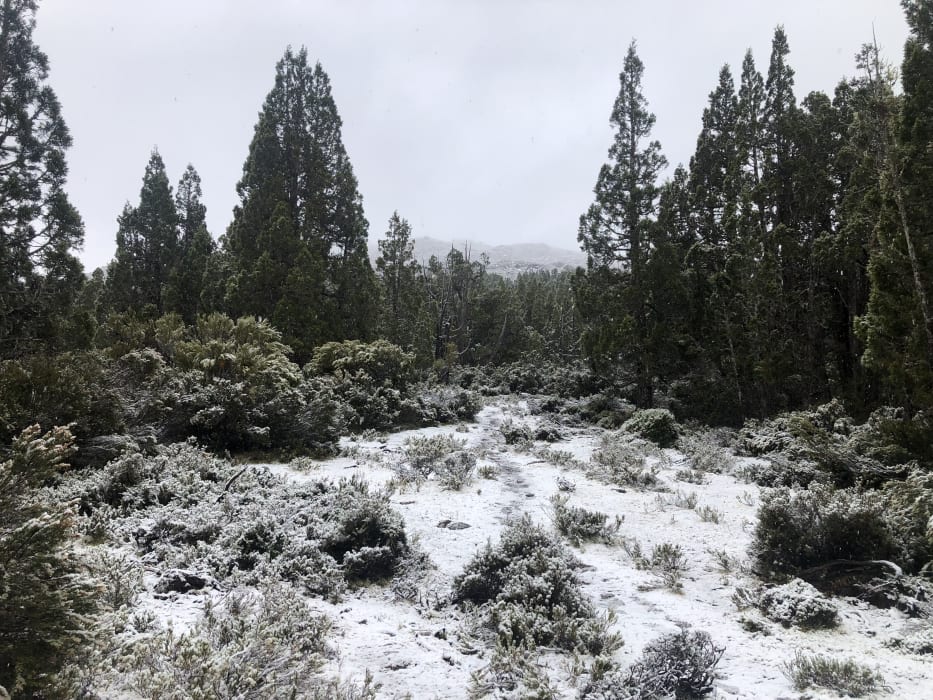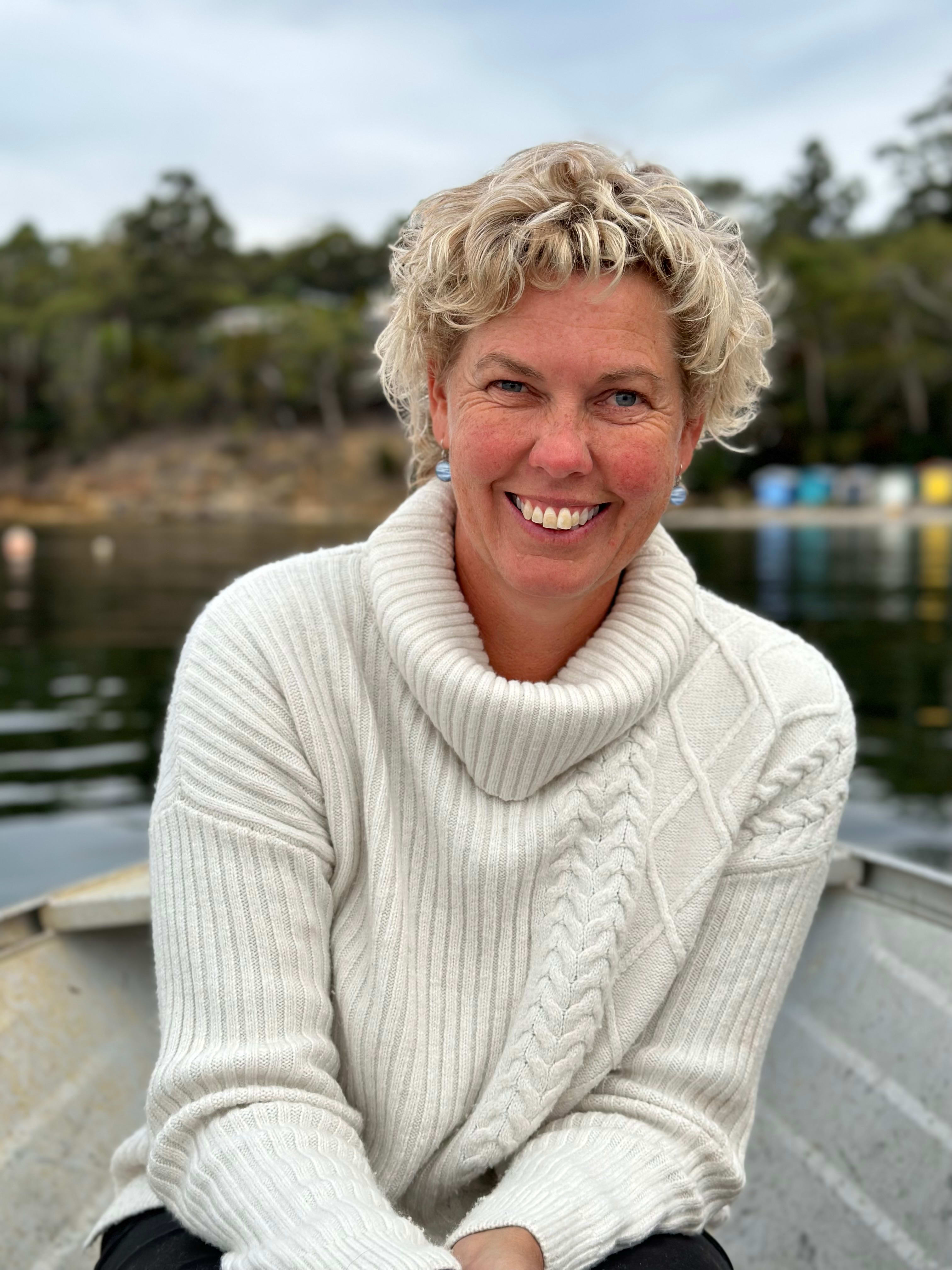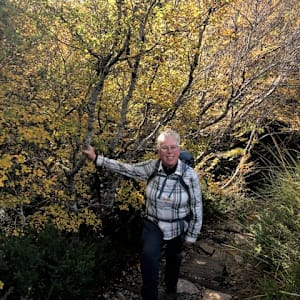writer and photographer SONIA STRONG
The sun has that unexpected ferocity of a Tasmanian high country summer's day. Don't tell the mainlanders, but for a couple of months it can get uncomfortably hot down here on the outskirts of Antarctica. I adjust my pack, check the map, and continue into one of the lesser-trafficked areas of The Walls of Jerusalem National Park.
Despite my job as a “wilderness” ranger, I spend much of my time in the main campsites. Typical conversations revolve around cushion plants, hiking routes, the merits of gear options, where not to wash one’s dishes/underpants/armpits and, invariably, the weather.
Today however, I am investigating one of the park's more remote reaches and haven't yet seen another human. Moving amongst sparkling glacial tarns and ancient pencil pine forests, I search for a suitable lunch stop and pause to congratulate myself on my employment choices.
Pines are not trees one typically associates with the Australian landscape. However, on many a Tasmanian bushwalk I've heard international tourists exclaiming how European the landscape here feels, an impression no doubt attributed to the stands of native king billy and pencil pine which persist in pockets across Tasmania’s Central Plateau.
Sadly, due primarily to harvesting and fire, the state’s native pine numbers have declined significantly since Europeans arrived. The survivors are often found clustered around the relative safety of streams, lakes and tarns. Their vulnerability to fire is compounded by exceptionally slow growth rates and the fact that their seeds only disperse a few metres from the parent tree. Native pines that do survive are typically capable of reaching remarkable ages, with some Huon pines dated at well over 2,000 years old. The pencil pines I’m sharing my scroggin with today have quietly stood their ground four to five times longer than Europeans have lived here. I feel obliged to do what I can to assist these stoic sentinels to reach the grand old ages to which they're genetically entitled.
. . .
A thousand odd kilometres north of The Walls, and thirty years across time, one of the pencil pines' relatives is receiving assistance from New South Wales park ranger Michael Sharp. A helicopter's downdraft buffets him as he jiggles about like a tea bag at the end of 60 metres of rope. It is the mid 1990s, and his location is one of the most tightly held secrets in Australian conservation history. The reason behind this perilous mission is pine cone collection from the canopy of a tiny, isolated (and as far as anyone knows, the only) grove of one of the world's oldest living plants, the Wollemi pine. Even today, the location remains a secret to all but a handful of trusted park managers and scientists.
Since the Wollemi pines’ discovery in 1994, and subsequent cloning, the species has been made widely available for backyard admiration across the country. Enormous work has been put into ensuring the species’ survival, with the successful results of a mammoth research and propagation effort evident in the ready availability of Wollemi pines in most plant nurseries. Alongside prioritising the protection of the last known stand of these trees from fire, disease introduction and human disturbance, all those backyard plantings have been critical to the species’ ongoing survival. Having these pines so readily available has been key to raising awareness of their tenuous survival in the wild.

I'm not the first to say it, but it's hard to value something you don't know much about. Raising awareness of how special this place is is at least half the reason I'm out here in the Tasmanian Wilderness World Heritage Area, talking to visitors. I certainly don’t come for the dehydrated food or lack of showers. Repeatedly, I'm surprised by how little the average park visitor knows about the global significance of where we are, a place which ticks as many World Heritage criteria as anywhere on the planet.
About 60 per cent of Tasmania’s alpine plant species for example, occur nowhere else on Earth. These glacially carved mountains are also home to many unique animals, like tiny mountain shrimp essentially unchanged since the Triassic, quietly sifting the sediments of alpine tarns as they have done for millions of years. Similarly, the last eastern quolls, now effectively extinct on mainland Australia, persist here despite sub-zero temperatures for much of the year. Tasmania also has its pantheon of endemic pines, almost as rare as the Wollemi.
Of Tasmania’s 11 native conifers, nine are endemic, and most are only found in the state’s remote and mountainous extremities.
Several Tasmanian pines are, like the Wollemi, available for sale in several excellent nurseries across the state. However, when I asked about buying pencil pines, I was put on a wait list, suggesting their propagation is small-scale at best. Given how successful resurrection of the Wollemi has been, it seems obvious to ask why we haven’t extended a similar helping hand to shore up the future of other native pine species. Perhaps they aren’t threatened enough yet. Or perhaps the answer lies in the fact that beyond their occasional use as pepper grinders and building poles (ie, Huon and celery top pines), Tasmanian conifers remain comparatively unfamiliar to most Australians.
The lesser-known species such as dwarf and creeping (strawberry) pine, the Mount Mawson pine, Laxifolias and king billy, may not be economically viable plantation species, but they are certainly still important. Shouldn’t we be metaphorically dangling beneath helicopters for these equally vulnerable ancients, the way Michael Sharp did for the Wollemi? Shouldn’t we be committing to their broad scale propagation in nurseries anywhere with a suitable climate in which to grow them?
Living and working in the park for week-long stretches has allowed for slow contemplation of the plants and animals of The Walls, to observe seasonal changes and to talk at length with passionate staff and knowledgeable park users. Whilst I have no peer-reviewed evidence to back this up, what I’ve learned during these conversations and observations has me worried about the future of some of the oldest pencil pines in existence.
For many years, The Walls area has been variously influenced by cattle grazing, trapping, Indigenous fire management, increased visitation, climate change (especially through the increased incidence of dry lightning ignitions) and changes in grazing/browsing pressure by native and introduced animals. You can't venture through the Central Walls area without disturbing a few Bennett's wallabies, which although native, add pressure to juvenile plants trying to establish themselves in an already harsh environment. Introduced fallow deer have also expanded their numbers to the point where aerial culling has recently been deemed necessary.
What is not evident in large numbers, however, is young pencil pines. The occasional tiny sapling can be found toughing it out in a hard to reach fallen tree, or between rocks in a boggy soak, but there is an obvious lack of next-generation trees coming through in these ancient forests. When it takes a pencil pine about 50 years to grow a single metre in height, protecting the next generation is critical to the forests’ long-term survival.
As anyone who has taken a road trip across Tasmania knows, there’s at least one pine species not under threat here, the introduced, fast-growing (and therefore commercially lucrative), Radiata pine. Save for a few fairies on red toadstools, their plantation monocultures are largely devoid of other life, the ground beneath acidified and mulched under a bed of pine needles. Driving through endless hillsides of Radiata, I can't help but notice how their fragrant branches bobbing in the breeze seem to be giving us all the finger.
Occasionally on such road trips, I’ve stumbled across abandoned trial coups of other pine species, such as redwoods and spruce, planted speculatively at some point to assess their viability. Clearly, they were found wanting against some short-term commercial criteria, but imagine if past forestry managers had had the foresight to plant stands of native specialty timber species. Imagine if they'd thought in terms of future generations, not just how many harvests were possible in one human lifetime. Imagine if the managers of forests had the same patience as the trees themselves ... but humans aren't known for their patience, when there’s a dollar to be made.
As I again sit quietly in a copse of pencil pines, shadows slanting in the last rays of the day, I hold my breath as a young devil grunts her way across the moss. I am struck by how strange it is to value something more when it becomes rare, to appreciate it only when faced with the prospect of losing it forever. Of course, there’s no more obvious local example of this than the thylacine, a majestic predator hunted to extinction with government-subsidised encouragement. Now the animals themselves are gone, we have instead their ironic likeness emblazoned on number plates, buses and government letterheads. We even entertain the idea of artificially resurrecting them from the dead. All this whilst staring into the face of an exponential extinction wave, and growing threats to many species, about which we could still do something. We are strange creatures indeed.
Sonia Strong moved to Tasmania in 2005 and lives in the forested hills of the D’Entrecasteaux Channel. She has worked in conservation and alpine/marine park management, as a paramedic and recently, as a wilderness ranger. She is also a metalsmith, writer and painter. She has a deep affection for windswept and interesting people and places and is happiest when creating, immersed in a creek looking for sapphires, exploring wild places or in the sunshine with wine and friends. Sonia has published several children’s books through Forty South, including “Tazzie The Turbo Chook Finds Her Feet”. You can follow her on Instagram, @soniastrongartist.















